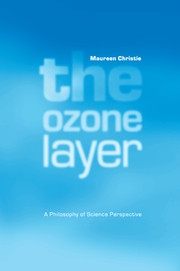Book contents
- Frontmatter
- Contents
- List of figures
- List of abbreviations
- Preface
- 1 Introduction
- Part I History of the understanding of stratospheric ozone
- 2 Stratospheric ozone before 1960
- 3 Chlorinated fluorocarbons
- 4 The Supersonic Transport (SST) debate
- 5 Molina and Rowland: chlorine enters the story
- 6 Too much of a good thing? Crucial data backlog in the Antarctic ozone hole discovery
- 7 Antarctic ozone hole – theories and investigations
- 8 Completing the picture: from AAOE to 1994
- Part II Philosophical issues arising from the history
- References
- Index
5 - Molina and Rowland: chlorine enters the story
Published online by Cambridge University Press: 22 September 2009
- Frontmatter
- Contents
- List of figures
- List of abbreviations
- Preface
- 1 Introduction
- Part I History of the understanding of stratospheric ozone
- 2 Stratospheric ozone before 1960
- 3 Chlorinated fluorocarbons
- 4 The Supersonic Transport (SST) debate
- 5 Molina and Rowland: chlorine enters the story
- 6 Too much of a good thing? Crucial data backlog in the Antarctic ozone hole discovery
- 7 Antarctic ozone hole – theories and investigations
- 8 Completing the picture: from AAOE to 1994
- Part II Philosophical issues arising from the history
- References
- Index
Summary
In 1971, a suggestion was made in a letter to Nature that CFCs could be used as markers for wind patterns and currents (Lovelock, 1971). James Lovelock had been involved with the development of the electron capture detector for use in gas chromatography. This provided a very sensitive means of detecting minute amounts of certain gases, but mainly only those that contain fluorine or chlorine. These gases could be detected and measured even when their mixing ratio was only a few parts per trillion. In exploring possible applications, Lovelock had made some observations on surface air in rural Ireland. An increase in CFC levels up to 20-fold occurred when the wind blew from the direction of continental Europe rather than from the North Atlantic Ocean. His suggestion was that air parcels which had come from industrial or heavily populated areas of Western Europe contained high levels of unreactive CFC gases, while those that had Arctic or oceanic origins had much lower levels.
This letter caught the attention of Professor Sherwood Rowland. His main interest was not in Lovelock's suggestion about monitoring air circulation patterns. He was more concerned about the fact that there was a measurable and not insignificant level of CFCs in the atmosphere – even in unpolluted atmosphere from the Arctic Sea. He included in his research grant application to the US Atomic Energy Commission a proposal to investigate the way that CFCs cycled through the atmosphere.
- Type
- Chapter
- Information
- The Ozone LayerA Philosophy of Science Perspective, pp. 29 - 37Publisher: Cambridge University PressPrint publication year: 2001



